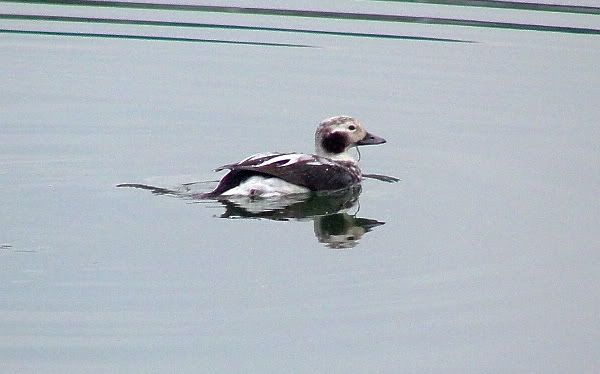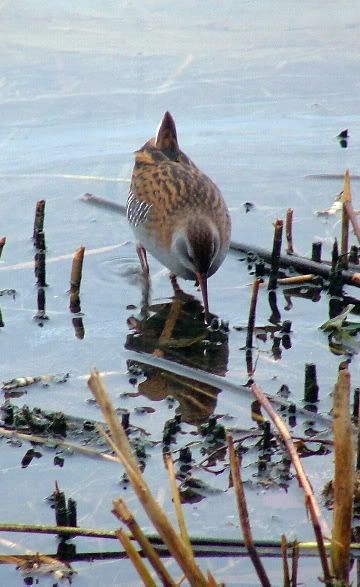
Monday, 31 December 2007
Monday, 24 December 2007
Bittern by the Bird Bog
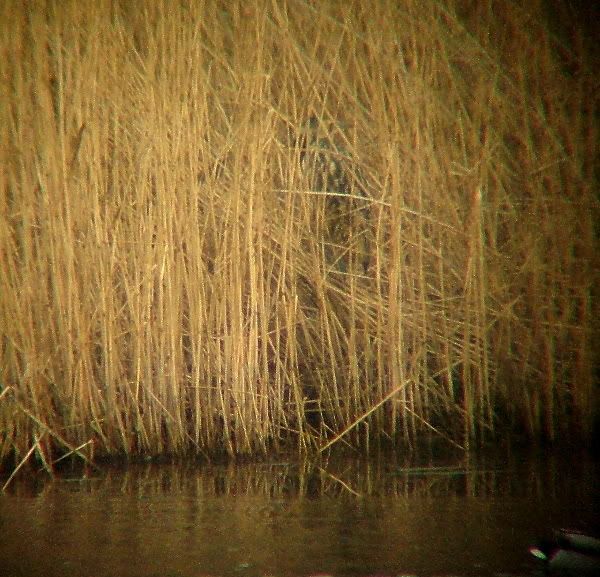 click to enlarge
click to enlargeLook close and look hard, look for the black markings on the back.
Potteric Carr, just south of sunny Doncaster, it's a big site, getting bigger, and full of birds. The star attraction here are Bittern. On any given day during the winter up to 6 birds are to be expected on the YWT reserve, and the neat part, as the staff was happy to tell me, is the they cut the edges of the otherview very thick reed beds fairly short, so you can see into the reeds a wee bit, which isn't done elsewhere. 'Best place in the country to see Bittern', he said. I could hardly disagree, we had three sightings through the day, of probably three different birds. They do not stay to breed on site yet, although there's no reason why they shouldn't soon begin to. Black-necked Grebe already do breed there (although are absent in winter), so that could be a fantastic spring/summer double in the future.
Our best view was when one Bittern flew right-to-left across Piper Marsh, which is apparently its uniform behaviour, as the bird circuits the reeds in a clockwise direction. The flight is far more direct than the languid wafting of Heron, they go much quicker than that. The tip I was given by the locals was look for the gulls to scatter from the water, as if in predator evasion mode, because they see the Bittern coming before we do and are bloody scared of it!
Run!
Other notables for the day included Water Rail - with ridiculously close views as they fed right out in the open under the bird table on Willow Marsh. That's a very good spot all round really, with 19 species on or around the feeders. As one might expect on a reclaimed northern industrial site, there were Willow Tits all over the place, Great Spotted Woodpecker, Bullfinch, and Jay, also showed well. There is a pair of the vastly declined Lesser Spotted Woodpecker around Potteric Carr, not to be seen during our visit though (nor since the previous Tuesday), indeed such difficult blighters are they to find that one report a week during the winter is about the going rate - and this is the best time of year to see them!
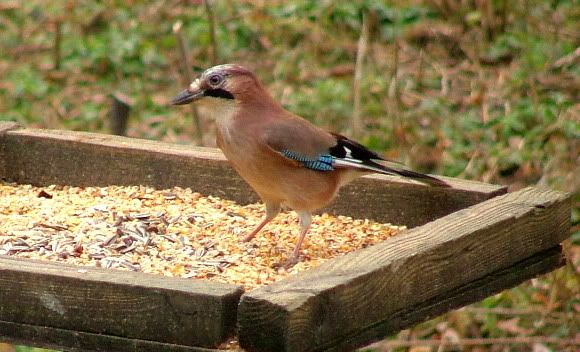
More videos of the day:
Video 1 - Dim distant Bittern preening, wait for the movement
Video 2 - Water Rail again
Video 3 - Jay
Labels:
birds,
birdwatching,
bittern,
doncaster,
jay,
potteric carr,
video,
water rail
Wednesday, 19 December 2007
Sleek Bird

Just a brief update on yesterday's ABB event at Carsington. Top bird had to be the Great Northern Diver (which has been around since November 10th). That makes this the second successive year we've had the species present. Last winter 2 or possibly even 3 birds stayed, with GND present from November through to May. Pretty neat to have this bulky marine species. It'll have come from Iceland and in the cold half of the year really belongs around our northern coasts.
Otherwise notable were two Peregrine, as usual best seen perched on the towering electricity pylons.
Visitor numbers weren't great, but should hopefully rise at the weekend with the arrival of Christmas holidays. Memorable person of the day was the lady utterly in love with Wigeon, her genuine favourite she said. There's a Simon Barnes piece in today's Times about the duck which must go someway toward explaining why - read here.
Monday, 17 December 2007
Willow Tits: On The Brink
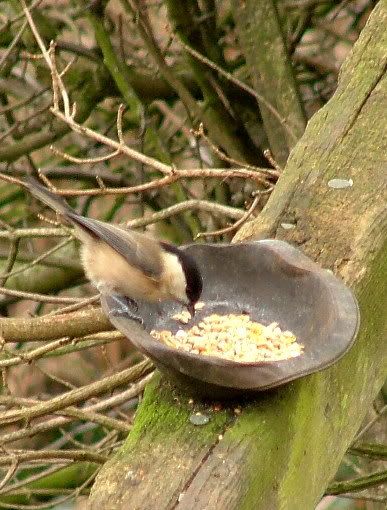 Quite a cold snap at the moment, so a good time to get out around my alternative local patch Brierley Forest Park and make sure the feeding stations are well stocked.
Quite a cold snap at the moment, so a good time to get out around my alternative local patch Brierley Forest Park and make sure the feeding stations are well stocked.Plenty out and about there, although the transient winter finch flocks, Redpoll and Siskin have moved on. Blackbird numbers are notably high with loose gatherings of 20 birds in several areas. Most gratifying birds to see, however, were Willow Tits, with 4 or 5 individuals congregating around the seed pots and hanging fat feeders.
The recent story of the Willow Tit is shocking both for the extreme decline in their numbers and for the lack of awareness of it. Just take a look at what happened to them in Kent. In 1996 there was estimated to be 500-900 pairs in the county, and now, it's probably none. There's a similar story over most of the south-east, East Anglia, much of Wales, indeed few are the regions in which they are not crashing or already extinct- Nottinghamshire/Derbyshire probably being their stronghold these days.
It may be that the very similar Marsh Tit, declined significantly itself since 1960's although probably levelling off now, provide the sort of ID confusion that lead birders to think there are Willows present in areas where they have lately disappeared from. The best way to tell between them is their call ( try listening at the RSPB website) - although even those can vary enough to be confused, and the slight plumage details aren't always sure fire either. General advice is to look for a slight wing-bar on the Willow Tit.
The national figures say it all really, a decline of 72% in the years 1994-2002, nearly three quarters gone in only eight years! Little wonder it was recently added to the Red List of species of greatest conservation concern.
There is still much debate over the cause of this catastrophic dip. The Willow Tit's weakness is its choosiness, only very wet young plantations of willow, birch and alder scrub, and occasionally pine, will do, so on sites where plantations are maturing, drying up or are being cleared of scrub, Willow Tits suffer quite badly. One influence on this change is the national boom in deer populations, Roe and Muntjac in particular will nibble away the undergrowth these birds rely upon. Coupled with general habitat loss to development and urban sprawl, and Willow Tits are running out of breeding sites.
The other theory that's given a lot of credence proves how difficult biodiversity can be to manage. Despite having an abominable 2007 when the heavy rains washed away all their caterpillar food, Blue Tits are generally on the increase in areas where Willow Tits are losing out. The evidence suggests to some that Willow Tits, the only tit species in Britain to excavate its own nest cavity, are muscled out of their territories and nest sites by the other tits. Mainly Blue Tits, but also Marsh and Great Tit will do this. Great Spotted Woodpecker are another additional pressure, as they will raid nests for chicks.
Studies are ongoing and we don't really have any answers just yet, and I'd suppose there won't be just one reason for the crash. I tend to wonder about the future and climate change. With dryer summers degrading their habitat further, more competitor species making it through milder winters, the future looks bleak for the Willow Tit, real into oblivion stuff.
Thankfully we still have them locally, chiefly due to all the old colliery sites around here that have been returned to nature and planted up in the last 20 years, sites such as Brierley.
They are also present at Carsington, and I'm volunteering there tomorrow. I just might begin adding Willow Tit to the conservation spiel I give to visitors.
Sunday, 16 December 2007
Doubling Ducks
Seemed like a while since the girlfriend and I had been on a local twitch, leafing through my entries here is was the Rutland Red-necked Grebe in October, so it was due. A quick browse of Birdguides (where would birders like me be without such websites?), came up with a nearby Long-tailed Duck just across the county border in Derbyshire, at a LNR called Williamthorpe Ponds. Upon arrival it turned out to be quite the typical modern local nature reserve, a small pocket of wildlife much surrounded by Acme industrial complexes Ltd.
...when the duck eventually stopped diving.
This Long-tailed Duck (#204 for my life list) has been a long stayer, present on site since late November, and true to form there it was, a mucky looking 1st-winter drake, with a tail of diminutive standards. Still cute faced as ducks go though, rather round of head with the facial expression of a sated puppy. These guys ordinarily winter at sea, and are fairly common on our northern coasts, hence the local twitch value of this inland bird here in the East Midlands. Most LTDs seen around the UK will have come from the breeding populations in Iceland and Greenland where they nest on lakes and freshwater marshes, feeding largely on crustaceans, molluscs, and aquatic invertebrates, during which they dive for long periods.
Our bird seems happy where he is, and quite fearless of man. Just a little patience and views within 10 yards would come. A really nice bird.
As ever, just being out and about brings its own rewards, this time a wandering Water Rail. Icy days seem to encourage them out of the reeds and this one walked with a couple of yards of us, utterly oblivious. It made for quite the most memorable encounter, and I could hear others squealing in the reeds. Check the video links below.
Other birds around included the regular winter ducks, both common grebes, and I heard a Willow Tit or two.
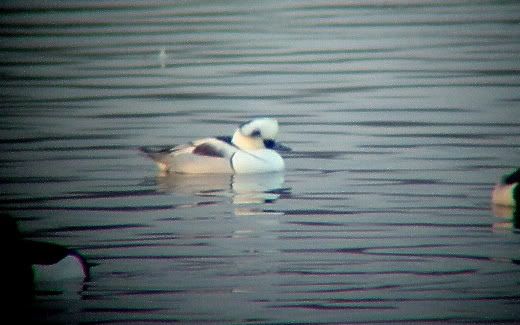 How cool?
How cool?The second scarce winter duck of the day was this gorgeous Smew back at one of my local haunts, Kings Mill Reservoir (you know it well by now if you read my bird blog), a neat stop off on the way home. Apparently only the fourth record for the site (check out the local recorder's website for more info), it drew in many a local birder, and happily a few non-birding passersby.
Winter males are always striking, for me their look harks of Walls vienetta, you know, that fancy white ice cream with the embedded wafers of chocolate. Historically Britain receives more wintering females than drakes, though I'm not so sure that's necessarily true these days, with around 200 mainly finding sites in the south-east, migrating from the lakes and rivers of northern Scandinavia and Russia where they breed. His diet mainly consists of small fish, larvae and invertebrates.
Winter males are always striking, for me their look harks of Walls vienetta, you know, that fancy white ice cream with the embedded wafers of chocolate. Historically Britain receives more wintering females than drakes, though I'm not so sure that's necessarily true these days, with around 200 mainly finding sites in the south-east, migrating from the lakes and rivers of northern Scandinavia and Russia where they breed. His diet mainly consists of small fish, larvae and invertebrates.
Friday, 14 December 2007
The Roost of the Wagtails

Here's a surprise treat, something I discovered during my walk to the bus station, it's an urban Pied Wagtail roost, in Mansfield. I knew there was one around the town centre, and there it is, in the lone beech tree tucked behind the closed down Tesco. Noticeable first because about half an hour after sunset, when the wagtails descend from the surrounding buildings there's quite the cacophony, almost giving the impression of a pet shop aviary given the high street location.
Quite difficult to photograph in the gloom though, so here's a dodgy video of the action.
For ten or twenty minutes before the wagtails came down to roost they circled quite high, gathering their numbers and emitting that familiar 'chiswick' call. Rather like Starling, they appear quite nervous, unwilling to be the first individual to touch down. Eventually it happened, half a dozen birds flitted into the roost, and then came a continual flurry for the next twenty minutes, getting louder and louder.
Difficult to estimate the total number, but by the end perhaps 120 birds came in, give or take. A quick explanation of this behaviour is that the birds find safety in numbers during the night and choose these urban settings because the micro-climate in our towns and cities tend to be a couple of degrees warmer than their more rural surroundings. The roosts are often traditional sites, with one used for at least 30 years, and some can contain thousands of birds. The largest one I'm currently aware of in my part of the world is in the centre of Nottingham, with reports of 850 individuals joining the roost. I try not to imagine the kind of mess them must leave below them.

Neater still, as I photographed the scene, shoppers stopped to look and listen to the spectacle, a couple of them venturing to ask me what birds there were. 'Lovely', and 'I would never have thought', were the sort of things they were saying.
And what else to say, but again it's a bird triumph, they wowed us again!
In other news, the girlfriend and I enjoyed a night at the cinema this week, as we went to see the exceptional new French version of Lady Chatterley. I mention this for two reasons, it's full of birds, and, here's the terribly nerdy part, I spent moments during the film mentally noting the location errors - for example, we don't have Black Kite in this part of Nottinghamshire (I live where the story is set), despite the bird of prey depicted soaring over the woods. Heck, I really wish we had them!
Anyway, is it really, really, terribly sad to be noticing these things? Awful, I'm sure of it. I suppose that's how birders are, we never really switch it off.
That's all for now, but here's a couple more videos of the wagtail roost...
Video 1 - Wagtails
Video 2 - Wagtails
Video 3 - Wagtails
Labels:
mansfield,
Nottinghamshire,
pied wagtail,
roost,
urban birds,
video
Monday, 3 December 2007
It's Dipperdale, surely?
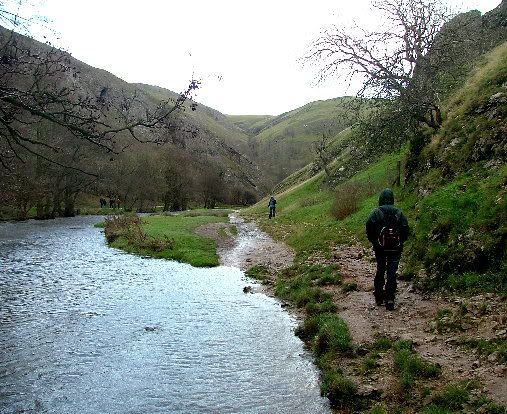 Isn't Britain wonderful? We're all of us in such easy reach of so many different landscapes. Over weekend the girlfriend and I picked out the unmatchable limestone beauty of Dovedale, on the Derbyshire/Staffordshire border. There was one bird, a favourite, that she wanted to see again, a species synonymous with Dovedale - the Dipper.
Isn't Britain wonderful? We're all of us in such easy reach of so many different landscapes. Over weekend the girlfriend and I picked out the unmatchable limestone beauty of Dovedale, on the Derbyshire/Staffordshire border. There was one bird, a favourite, that she wanted to see again, a species synonymous with Dovedale - the Dipper.Notice the blinking? Its eyelids look white or even silvery. That's called a nictitating membrane, somewhat like see-through eyelids or goggles by another name, which allow the bird to search for underwater food (mostly insect larvae, fresh water shrimp). Neat huh?
They also have a special preen gland and undercoating of feathers to keep them dry, and their blood is richer in oxygen than most other perching birds, all adaptations for a sub-aqua lifestyle.
I really doubt there is any place in the world where you can get closer views. The Dippers along this most popular stretch of the Derbyshire Dales barely register the presence of passersby, and with just a little patience you can be within feet of them.
The heavy rains of previous days made for a high river which perhaps explains why for our visit the Dippers fed almost exclusively duck-style, swimming and diving from the surface rather than skipping in and out of the fast waters around the rocks. For me it remains a bizarre sight, this bird not unlike a Blackbird, so at home on the water. Look...
By the way, I should probably explain that winter in the valley is really too dark to get decent still photographs, at least not with the primitive kit I carry. Far easier to instead record the day on video, even if it's only lo-res stuff. Most of these I digi-binned through my 8x42s.
So real crackers, one of those bold and brilliant birds complete strangers birders and bird novices alike, will stop, watch and talk to each other about. Top #10 British Bird for anyone's money.
Plenty else in the dale too though, dozens of Siskin and plenty of Nuthatch showed well in the car park, that universal companion of the Dipper - Grey Wagtail were just as numerous, Raven were a nice touch over the woods and again relatively decent views for such a shy species. Redwing, Treecreeper and Buzzard, kept things interesting away from the water.
Last bird of the day was a redhead Goosander on the river. She should probably think about moving down to a lake or reservoir for the winter.
There was more wildlife treat though, a bonus; stellar views of a Weasel foraging the river bank. You can never expect such a thing, but just by going out you win the occasional lottery and there it'll be. Memorable stuff.
The Goosander.
A couple more video links:
Dipper 1
Dipper 2
Last word, be careful on the stepping stones and think twice about crossing them in winter. We saw one accident with a mother and her kids ending up on their bottoms in the water, and it was only luck really that we had a blanket and spare coat to lend them from our car.
This isn't the time of year to be getting wet folks.
Subscribe to:
Comments (Atom)

